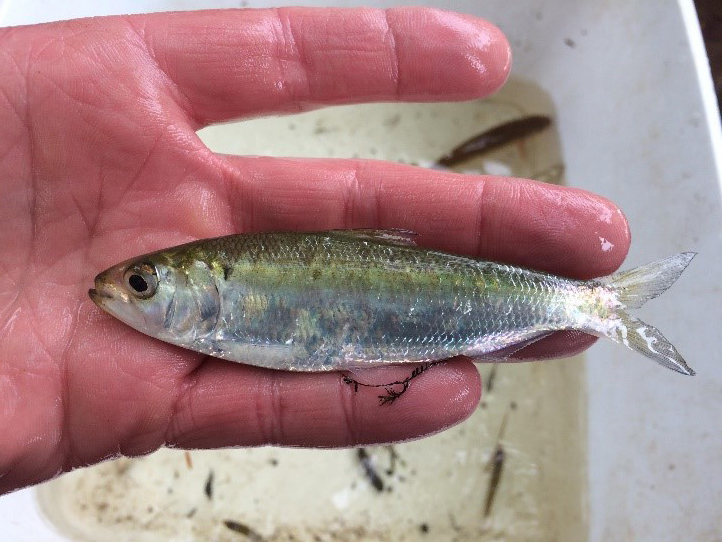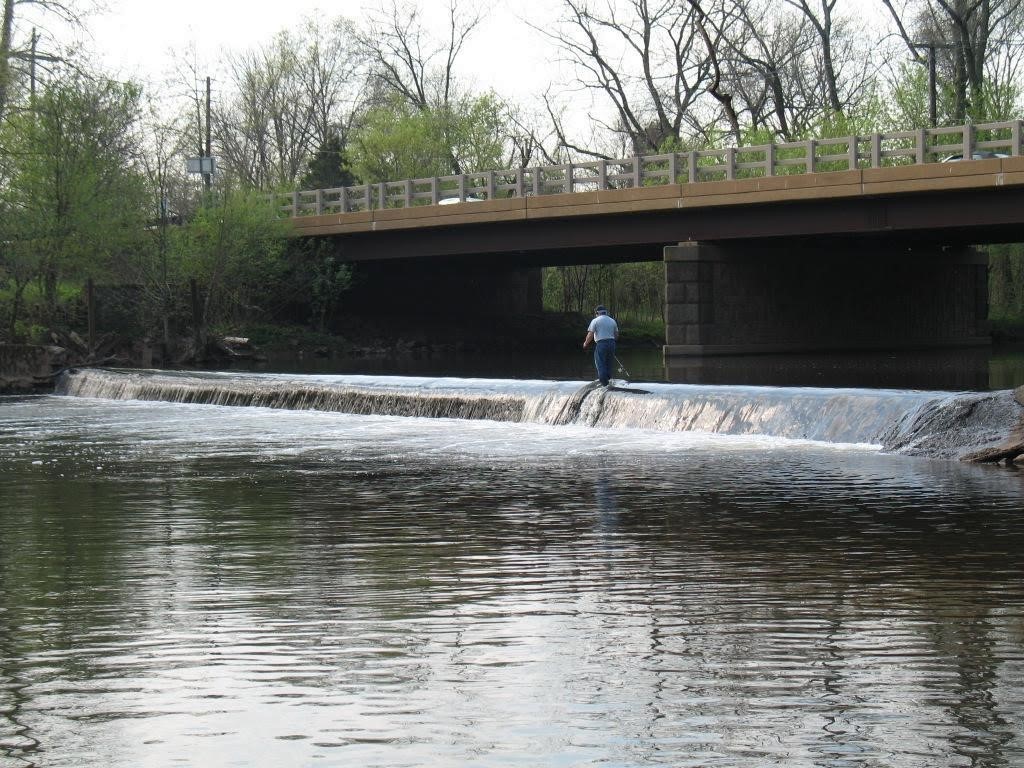AMERICAN SHAD SPAWNING CONFIRMED IN MILLSTONE RIVER FOLLOWING
2017 DAM REMOVAL IN MANVILLE, SOMERSET COUNTY
(18/P092) TRENTON – The New Jersey Department of Environmental Protection has confirmed that American Shad are migrating and spawning in the Millstone River for the first time in 173 years, a year after removal of the waterway’s Weston Mill Dam in Manville, Commissioner Catherine R. McCabe announced today.
 Staff from the DEP’s Division of Fish and Wildlife, the U.S. Fish and Wildlife Service, and the Watershed Institute found evidence of successful American Shad spawning while cooperatively monitoring changes in fish assemblage following the summer 2017 removal of the Weston Mill Dam. Five juvenile shad averaging 4.3 inches in length were found 4.5 miles upstream of the dam at the base of Blackwell’s Mills Dam, which is considered the next upstream impediment to the movement of the shad. No shad have been found upstream of this location.
Staff from the DEP’s Division of Fish and Wildlife, the U.S. Fish and Wildlife Service, and the Watershed Institute found evidence of successful American Shad spawning while cooperatively monitoring changes in fish assemblage following the summer 2017 removal of the Weston Mill Dam. Five juvenile shad averaging 4.3 inches in length were found 4.5 miles upstream of the dam at the base of Blackwell’s Mills Dam, which is considered the next upstream impediment to the movement of the shad. No shad have been found upstream of this location.
“This is great news and a wonderful environmental success story,” Commissioner McCabe said. “These juvenile shad were found in the first unimpeded migratory season after removal of the Weston Mill Dam, indicating this species has an inherent tendency to recolonize once obstacles are removed from its migratory path.”
A study to evaluate anadromous fish upstream of the Weston Mill Dam was initiated during fall 2016. The study provided baseline data a year prior to the removal of the dam, with subsequent monitoring to continue through spring 2020. Monitoring the fishery provides an important demonstration of the efficacy of dam removal to restore migratory fishes and to help determine which future dam removal projects will provide the greatest ecological benefits.
Sampling is done in the spring to capture adults during their migration into fresh waters and again in the fall to document juveniles before they begin their outmigration to the ocean. Potential changes to the resident fish species and abundance above and below the dam following removal is also being evaluated.
“The presence of young shad is the culmination of the efforts put forth by an extensive partnership to open the river back up to migratory fish species,” Assistant Commissioner for Natural and Historic Resources Ray Bukowski said. “Not only did adults make it this far, but we now have their offspring to show for it.”
 Until its removal in summer 2017, the Weston Mill Dam blocked the migration of American Shad in the Millstone River for 173 years. Structures such as these are known as low-head dams and were built many decades and even centuries ago to power mills, generate electricity and create lake-like sections of impounded water. Low-head dams create stagnant stretches of rivers that can be low in dissolved oxygen that aquatic life needs, while exacerbating excessive algae growth that can diminish recreational and scenic enjoyment.
Until its removal in summer 2017, the Weston Mill Dam blocked the migration of American Shad in the Millstone River for 173 years. Structures such as these are known as low-head dams and were built many decades and even centuries ago to power mills, generate electricity and create lake-like sections of impounded water. Low-head dams create stagnant stretches of rivers that can be low in dissolved oxygen that aquatic life needs, while exacerbating excessive algae growth that can diminish recreational and scenic enjoyment.
Low-head dams also may pose dangers to kayakers and canoers who can find themselves trapped in a vortex of churning water if they accidentally tumble over the structures.
Removal of the Weston Mill Dam was completed in accordance with the terms of a Natural Resource Damages settlement agreement between Wyeth Holdings LLC and the DEP, the U.S. Fish and Wildlife Service, and the U.S. Department of Commerce’s National Oceanic and Atmospheric Administration. Per the agreement, Wyeth Holdings LLC funded the cost of the removal as well as the costs of pre- and post-monitoring. The agreement calls for Wyeth to implement the project to compensate the public for natural resource injury resulting from past pollution to the Raritan River from the American Cyanamid Superfund site in Bridgewater Township. Wyeth inherited responsibility for the American Cyanamid site through corporate successorship.
Natural Resource Damage settlements also resulted in the removal of the Calco dam on the Raritan River mainstem, which facilitated migratory species such as American Shad reaching the Millstone River. The Nevius Street and Robert Street dams, further upstream on the Raritan River were also removed as part of the same settlement.
Other partners in the Raritan Basin effort include American Rivers, Conservation Resources Inc., the Geraldine R. Dodge Foundation, the Horizon Foundation, and the Raritan River Fish Passage Initiative.
“Removal of the Weston Mill Dam represents an important step in the restoration of the Millstone River and the larger Raritan River Basin,” said Jim Waltman, Executive Director of the Watershed Institute. “We are proud to be working in partnership with federal and state conservation agencies to restore migratory fish, improve water quality, and remove a dangerous obstacle to recreational use of the Millstone River.”
For additional background about removal of the Weston Mill Dam, visit https://www.nj.gov/dep/damsafety/about.htm.
To learn more about dams in New Jersey, visit www.nj.gov/dep/damsafety/about.htm.
For more information about the Division of Fish and Wildlife, visit www.njfishandwildlife.com/.
Like the Division of Fish and Wildlife’s Facebook page at www.facebook.com/NJFishandWildlife/.
Follow the Division of Fish and Wildlife on Instagram @newjerseyfishandwildlife.
Follow the DEP on Twitter @NewJerseyDEP.
###